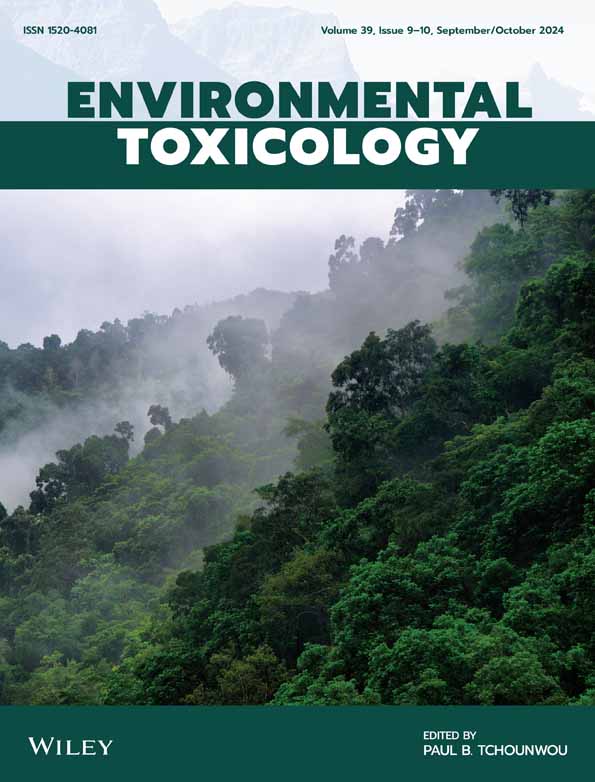Xiaoyan Yuan, Yimei Wang, Lizhong Li, Wei Zhou, Dongdong Tian, Chunfeng Lu, Shouzhong Yu, Jun Zhao, Shuangqing Peng
下载PDF
{"title":"PM2.5 induces embryonic growth retardation: Potential involvement of ROS-MAPKs-apoptosis and G0/G1 arrest pathways","authors":"Xiaoyan Yuan, Yimei Wang, Lizhong Li, Wei Zhou, Dongdong Tian, Chunfeng Lu, Shouzhong Yu, Jun Zhao, Shuangqing Peng","doi":"10.1002/tox.22203","DOIUrl":null,"url":null,"abstract":"<div>\n \n <p>Airborne fine particulate matter (PM<sub>2.5</sub>) is an “invisible killer” to human health. There is increasing evidence revealing the adverse effects of PM<sub>2.5</sub> on the early embryonic development and pregnancy outcome, but the molecular mechanism underlying PM<sub>2.5</sub>-induced embryotoxicity is largely unknown. Previous studies have documented that exposure to PM triggers ROS generation, leads to subsequent activation of MAPKs signaling, and results in corresponding cell biological changes including enhanced apoptosis and altered cell cycle in the cardiopulmonary system. Here, we investigated whether ROS-MAPKs-apoptosis/cell cycle arrest pathways play an important role in PM<sub>2.5</sub>-induced embryotoxicity using the rat whole embryo culture system. The results showed that PM<sub>2.5</sub> treatment led to embryonic growth retardation at concentrations of 50 μg/ml and above, as evidenced by the reduced yolk sac diameter, crown-rump length, head length and somite number. PM<sub>2.5</sub>-induced embryonic growth retardation was accompanied by cell apoptosis and G0/G1 phase arrest. Furthermore, ROS generation and subsequent activation of JNK and ERK might be involved in PM<sub>2.5</sub>-induced apoptosis and G0/G1 phase arrest by downregulating Bcl-2/Bax protein ratio and upregulating p15<sup>INK4B</sup>, p16<sup>INK4A</sup>, and p21<sup>WAF1/CIP1</sup> transcription level. In conclusion, our results indicate that ROS-JNK/ERK-apoptosis and G0/G1 arrest pathways are involved in PM<sub>2.5</sub>-induced embryotoxicity, which not only provides insights into the molecular mechanism of PM<sub>2.5</sub>-induced embryotoxicity, but also may help to identify specific interventions to improve adverse pregnancy outcomes of PM<sub>2.5</sub>. © 2015 Wiley Periodicals, Inc. Environ Toxicol 31: 2028–2044, 2016.</p></div>","PeriodicalId":11756,"journal":{"name":"Environmental Toxicology","volume":"31 12","pages":"2028-2044"},"PeriodicalIF":3.2000,"publicationDate":"2015-10-15","publicationTypes":"Journal Article","fieldsOfStudy":null,"isOpenAccess":false,"openAccessPdf":"https://sci-hub-pdf.com/10.1002/tox.22203","citationCount":"22","resultStr":null,"platform":"Semanticscholar","paperid":null,"PeriodicalName":"Environmental Toxicology","FirstCategoryId":"3","ListUrlMain":"https://onlinelibrary.wiley.com/doi/10.1002/tox.22203","RegionNum":3,"RegionCategory":"医学","ArticlePicture":[],"TitleCN":null,"AbstractTextCN":null,"PMCID":null,"EPubDate":"","PubModel":"","JCR":"Q2","JCRName":"ENVIRONMENTAL SCIENCES","Score":null,"Total":0}
引用次数: 22
引用
批量引用
Abstract
Airborne fine particulate matter (PM2.5 ) is an “invisible killer” to human health. There is increasing evidence revealing the adverse effects of PM2.5 on the early embryonic development and pregnancy outcome, but the molecular mechanism underlying PM2.5 -induced embryotoxicity is largely unknown. Previous studies have documented that exposure to PM triggers ROS generation, leads to subsequent activation of MAPKs signaling, and results in corresponding cell biological changes including enhanced apoptosis and altered cell cycle in the cardiopulmonary system. Here, we investigated whether ROS-MAPKs-apoptosis/cell cycle arrest pathways play an important role in PM2.5 -induced embryotoxicity using the rat whole embryo culture system. The results showed that PM2.5 treatment led to embryonic growth retardation at concentrations of 50 μg/ml and above, as evidenced by the reduced yolk sac diameter, crown-rump length, head length and somite number. PM2.5 -induced embryonic growth retardation was accompanied by cell apoptosis and G0/G1 phase arrest. Furthermore, ROS generation and subsequent activation of JNK and ERK might be involved in PM2.5 -induced apoptosis and G0/G1 phase arrest by downregulating Bcl-2/Bax protein ratio and upregulating p15INK4B , p16INK4A , and p21WAF1/CIP1 transcription level. In conclusion, our results indicate that ROS-JNK/ERK-apoptosis and G0/G1 arrest pathways are involved in PM2.5 -induced embryotoxicity, which not only provides insights into the molecular mechanism of PM2.5 -induced embryotoxicity, but also may help to identify specific interventions to improve adverse pregnancy outcomes of PM2.5 . © 2015 Wiley Periodicals, Inc. Environ Toxicol 31: 2028–2044, 2016.
PM2.5诱导胚胎生长迟缓:ros - mapks -凋亡和G0/G1阻滞通路的潜在参与
空气中的细颗粒物(PM2.5)是危害人体健康的“隐形杀手”。越来越多的证据表明PM2.5对早期胚胎发育和妊娠结局的不利影响,但PM2.5诱导胚胎毒性的分子机制在很大程度上是未知的。先前的研究表明,暴露于PM会触发ROS的产生,导致随后MAPKs信号的激活,并导致相应的细胞生物学变化,包括心肺系统中细胞凋亡增强和细胞周期改变。在这里,我们利用大鼠全胚胎培养系统研究ros - mapks -凋亡/细胞周期阻滞通路是否在pm2.5诱导的胚胎毒性中发挥重要作用。结果表明:PM2.5浓度在50 μg/ml及以上时,会导致胚胎发育迟缓,表现为卵黄囊直径、冠臀长、头长和体数减少;pm2.5诱导的胚胎生长迟缓伴随着细胞凋亡和G0/G1期阻滞。此外,ROS的产生和随后JNK和ERK的激活可能通过下调Bcl-2/Bax蛋白比例和上调p15INK4B、p16INK4A和p21WAF1/CIP1转录水平参与pm2.5诱导的细胞凋亡和G0/G1期阻滞。综上所述,我们的研究结果表明ROS-JNK/ erk凋亡和G0/G1阻滞通路参与了PM2.5诱导的胚胎毒性,这不仅为PM2.5诱导胚胎毒性的分子机制提供了新的思路,而且可能有助于确定改善PM2.5不良妊娠结局的具体干预措施。©2015 Wiley期刊公司环境毒理学杂志,2016,31(1):2028-2044。
本文章由计算机程序翻译,如有差异,请以英文原文为准。

 求助内容:
求助内容: 应助结果提醒方式:
应助结果提醒方式:


